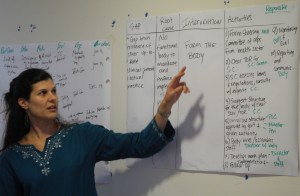Stage 6: Implement interventions
The goal of this stage is to execute the intervention package selected and designed in the previous stage. During the implementation stage, the OPQ team assures organizational readiness, applies the interventions, and helps enable and monitor organizational change. In accordance with the implementation plan, each aspect of each intervention is carried out by the person or team with assigned responsibility for it, and all actions are continually monitored and documented to determine how the process is moving forward and allow the process to be modified as needed. Documenting progress, challenges, and achievements is crucial to the implementation process and feeds into the next stage.
Step 6.1: Build the implementation team
The first step is to confirm who is on the implementation team and ensure they understand their individual and shared roles. OPQ team roles for implementing interventions include:
- Developing an implementation/action plan
- Identifying persons/organizations with appropriate expertise and/or experience to implement the interventions
- Assuring that team members know roles, responsibilities, and expectations for interventions
- Identifying and mobilizing resources
- Carrying out and managing interventions
- Monitoring and documenting change using an M&E plan (see Stage 7)
Step 6.2: Develop a detailed implementation action plan
 The OPQ team should construct an overall plan detailing the entire implementation structure and the role of each individual. Because OPQ focuses on results, it is also important to maintain clarity about the performance expectations of each intervention.
The OPQ team should construct an overall plan detailing the entire implementation structure and the role of each individual. Because OPQ focuses on results, it is also important to maintain clarity about the performance expectations of each intervention.
An implementation action plan is a simple tool to use when planning, carrying out, and monitoring an intervention. See a sample Implementation Action Plan Format in the Tools section. It includes:
- Planned activities
- Person responsible for each activity
- Required resources
- Date by which each activity will be accomplished
- Expected result and how it will be measured
Step 6.3: Conduct and monitor activities
Once the implementation is underway, the role of the OPQ team switches to monitoring and carrying out the performance of interim evaluations. At the milestone points in the implementation plan, the team should assess milestone goals, provide feedback, and use monitoring data to make decisions. If deadlines slip, the team should recalculate the project timeline and inform other implementation team members of any necessary changes in their deadlines.
Implementation problems and slippage of deadlines often have cost implications. The OPQ team should therefore monitor actual costs or expenses against amounts budgeted. Cost monitoring should be integrated with other monitoring activities.
When monitoring OPQ interventions, it is important to pay close attention to the organizational change process and the degree to which it is affecting interventions. This may include monitoring and documenting the changes that are occurring when planning for and transitioning leadership of the OPQ process to an internal team or stakeholder group. During implementation, the key stakeholders should make several checks to ensure that the organization is successfully integrating the changes that are occurring as part of the implementation process. Even the best-designed interventions will not succeed unless you have ensured that management support remains strong.
As mentioned in Stage 2, Introducing and Monitoring Organizational Change and the Monitoring Change Checklist in the Tools section contain information about introducing and monitoring organizational change, including assessing organizational readiness for change.
Informed and supportive stakeholders can help conquer obstacles that arise during implementation and assist in resolving problems stemming from changes in the external environment that are impeding the progress of interventions. Their strategically coordinated involvement also helps the dissemination of results at this stage and increases the potential for applying OPQ in additional settings.
